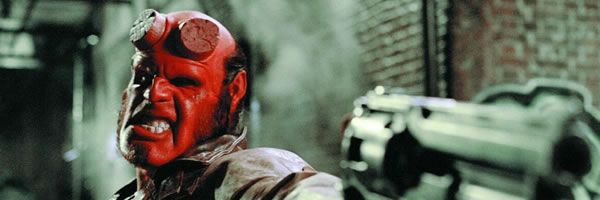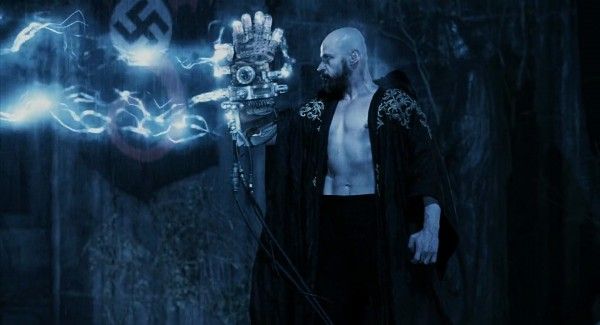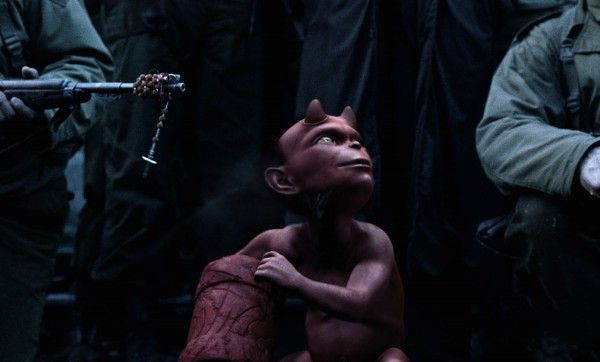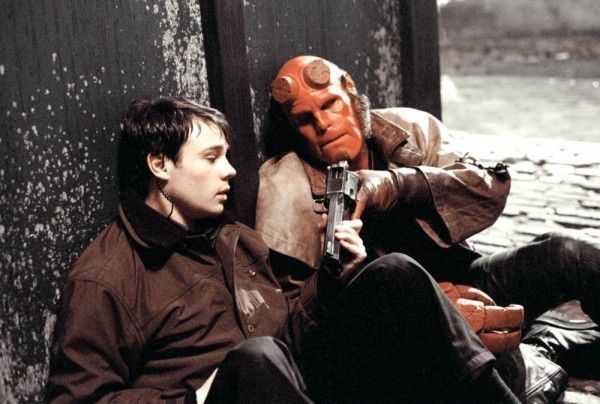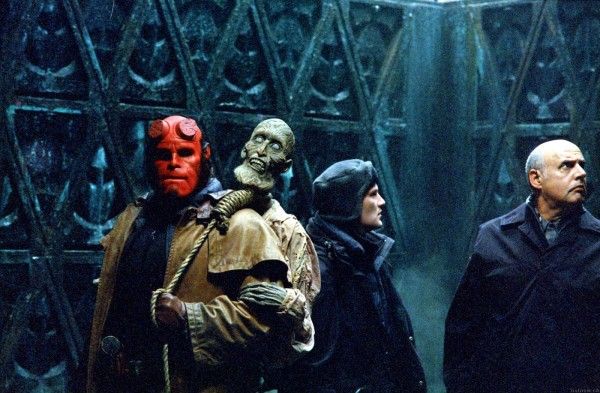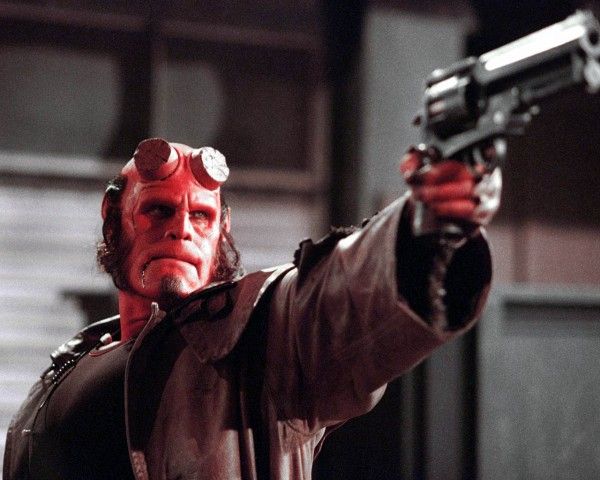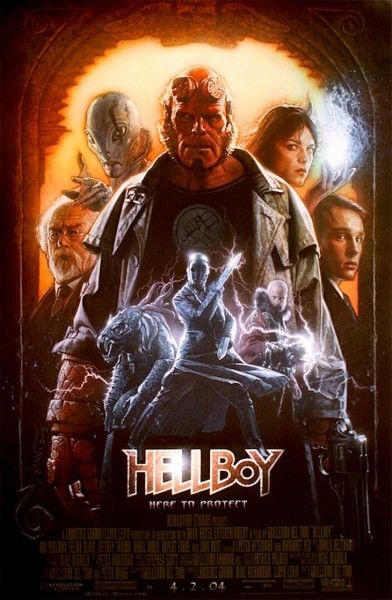[With Guillermo del Toro’s new movie Crimson Peak opening Friday, I decided to take a look back at the director’s filmography.]
On the one hand, Hellboy is a movie that probably shouldn’t exist. It’s too esoteric, it’s too weird, it has no A-list movie stars, it’s got a weird title, and there are a myriad of other reasons why Guillermo del Toro’s adaptation of Mike Mignola’s comic book never should have happened, and yet I’m grateful it did. It’s a movie where you can feel a director trying to strike a compromise, but unlike Mimic where he was struggling to win even the most minor battles, Hellboy is an attempt to get mainstream audiences to play on del Toro’s terms.
The story could easy have spun into high camp, but del Toro never winks at the camera. If Grigori Rasputin (Karel Roden), his “She-Wolf of the SS”-style Nazi girlfriend Ilsa (Biddy Hodson), and a clockwork leader of Hitler’s occult society Karl Ruprecht Kroenen (Ladislav Beran) want to summon the apocalypse through an interdimensional portal with the help of Nazis, then that’s where this movie is going to start, dammit. Grigori is foiled by the nerdy professor Trevor “Broom” Bruttenholm (Kevin Trainor) and American soldiers, but not before a little red boy with horns and giant stone fist comes through to our side.
Hellboy feels like a more accurate depiction of del Toro’s personality than his previous studio films. If Blade II was del Toro coming in through the door, Hellboy is re-decorating the room to his liking. The basics are still the same—both characters are “monsters” who have to work in the shadows to save humanity, but while Blade II is couched in coolness, Hellboy is a total outsider relegated to the status of Bigfoot or the Lochness Monster.
And yet one of the most appealing aspects of Hellboy (Ron Perlman) as a character is his blue-collar attitude. He can’t walk among us even if, in terms of his personality, he would fit in perfectly as the guy at the end of the bar talking shit about the local sports team. The movie isn’t a 1:1 adaptation of Mignola’s comics (specifically, Hellboy takes most of its plot from the graphic novel Seed of Destruction and a little from the short story “The Corpse”), but he gets what matters most, and part of that is Hellboy having a working class personality. Hellboy isn’t cool like Blade, and he treats fighting monsters the same way as a guy who has to work at a waste disposal plant. It’s a living, it’s what he’s good at, but that doesn’t mean he has any deep reverence for it, nor does his job define him.
Mignola and del Toro wisely seized on the juxtaposition of a working-class attitude with Lovecraftian horror, and that carries over the film. More than any of del Toro’s movies before, Hellboy feels like we’re stepping into the director’s head even though so much of the film is coming from the pages of Mignola’s comic book. The amount of effort put into the design and the weird monsters is del Toro really showing off his passion for the material, and credit to Sony Pictures for letting him make a movie that would likely never have broad appeal. It’s too earnest and weird, and while del Toro’s adaptation is far from slavish, it’s a movie where every compromise is discordant with what you can see del Toro cares about.
That’s not to say that he was indifferent towards any part of the film, but there’s far more vigor and verve placed in watching Hellboy do his thing and fight a giant monster in the New York City subways, get kicked around, and have the elderly Professor Broom (John Hurt) talk about reliquaries filled with the salt from the tears of a thousand angels than there is in developing John Myers (Rupert Evans), who basically functions as a tour guide who will hold the hand of a theoretical audience member that buys a ticket to see a movie called Hellboy, but would prefer not to see anything weird happen in it.
John is a chore of a character not because he’s irritating or because Evans gives a bad performance, but because he’s tasked with doing the heavy lifting of trying to win over audience members to the film’s strangeness, which is in direct opposition to the film’s ethos. Hellboy is a celebration of the “freaks” like its titular character alongside Liz Sherman (Selma Blair), telepath Abe Sapien (Doug Jones, voiced by David Hyde Pierce), and Broom. These are outsiders, and along comes the Boy Scout John Myers who probably never had a trouble fitting in anywhere a day in his life.
John Myers is the face of compromise in the film. When the film starts to crawl in the second act and the team has just faced a major setback following an attack in the sewers, the movie goes on a weird detour so that Hellboy can feel jealous of John going on a date with Liz. On the one hand, the movie is leaning into Hellboy just being a regular guy, albeit a bit clumsily (he’s basically stalking her), but on the other hand, it’s like you can read the studio notes “Make Hellboy more relatable,” as if constantly throwing everyman Myers on screen is going to make the big, red hero of the film more normal.
Despite throwing Myers in, Hellboy at its core is del Toro’s movie to the end, right down to the themes he loves exploring with regards to what makes a person human and what makes them a monster. The trappings may be more in line with del Toro’s nerdy interests, but it’s a film that kicks off with Broom narrating “What makes a man a man?” (And doesn’t expect the audience to immediately think of how The Dude responded to that question in The Big Lebowski). It comes to the same answer as del Toro’s previous movies (self-sacrifice), but for a movie packed with monsters and ancient mythology, the answer becomes more important, especially when you’re presenting a story that’s ultimately lighter and yet still more earnest than his previous movies. It doesn’t matter how big the stakes are; it’s the universal humanity in all of us, whether you’re a regular guy, or a regular guy trapped in the body of the demon that’
I love that Hellboy isn’t called “Heckboy”. I love that Hellboy isn’t a regular guy who turns into Hellboy when he gets angry. I love that it’s Ron Perlman playing this role. Hellboy shows that del Toro knew to fight the fights that needed fighting, and trying to make the rest of the film palatable as something in the vein of Men in Black, which I’m sure the studio desperately wanted. I’m almost a little surprised there’s not more at the B.P.R.D. (Bureau for Paranormal Research and Defense), but you can only pack so much weird stuff into one movie, especially a film that’s trying to be the crossover hit that every studio wants and so few get.
Hellboy was not a crossover hit. It underperformed at the box office, but was able to find its money on DVD. But for del Toro, he had bent the studio picture to his will, and while there were still some compromises, we had stepped into his weird world of occult Nazis, pancake-loving demons, and other strange places. It was an entry point for so many of the things del Toro adores, not just Mignola’s comic, but the horror influences that went into that comic. But his next movie wouldn’t just be what del Toro loved; it would be a labor of love.
Tomorrow: Pan’s Labyrinth
Other Entries:

